Cupar rail crash saw family seconds from death in 1988 accident
These dramatic photographs show the tangle of wreckage when a train of cement wagons derailed and struck a bridge in Cupar on June 2 1988.
The wagons were being hauled by Class 47 locomotive 47004, which careered off the rails past Cupar Station.
A Crieff couple and their five-year-old son had a lucky escape when they reversed away from Pitscottie Bridge just seconds before it was struck by the locomotive.
A Sprinter train was heading in the opposite direction.
Potential disaster was narrowly averted.
The accident happened at 7pm due to a combination of excessive speed and a rail fault.
Remarkably, no-one was seriously hurt.
What happened on June 2 1988?
The Courier reported: “The freight train demolished the rails before colliding with the bridge, sending debris into adjoining properties and on to the A940 road below.
“The driver, believed to be from Edinburgh, was on his way to Aberdeen.
“Amazingly, he was able to walk away from the wreckage unscathed.
“He was taken to Adamson Hospital, Cupar, however, to be treated for shock.
“Fortunately no one else was injured.
“The accident happened about 7pm, minutes before a southbound Sprinter service train was due to arrive.
“By the time it reached the accident scene the driver had been alerted and he managed to pull up a safe distance from the derailment.”
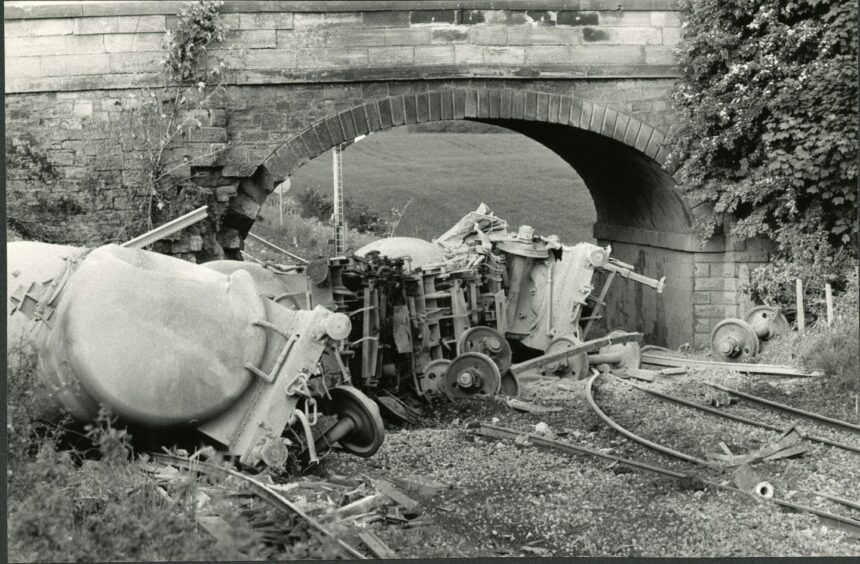 The cement wagons lie stricken beside the tracks following the accident. Image: DC Thomson.
The cement wagons lie stricken beside the tracks following the accident. Image: DC Thomson.
The Courier said the accident happened 50 yards east of the station and the main section of the train came to rest “a quarter of a mile after the first signs of derailment”.
A breaker’s yard next to the rail tracks was struck by flying debris.
Panel beaters Eric Westwater and Graham Forbes were working in the workshop.
“The noise was louder than usual, then we saw the engine go past and heard an almighty crash as one of the trucks hit the bridge,” said Mr Westwater.
Both he and his colleague were interviewed by the Courier reporter following the accident and said they believed the train had been travelling at a reasonable speed.
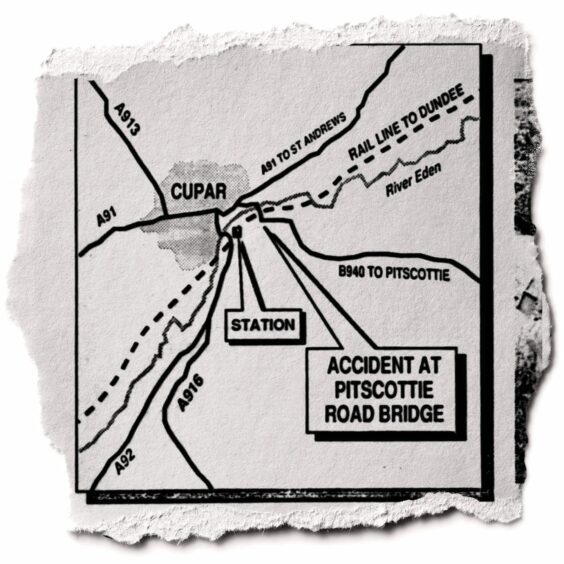 The Courier produced a map that showed where the accident happened. Image: DC Thomson.
The Courier produced a map that showed where the accident happened. Image: DC Thomson.
The Courier said: “Mr Westwater’s own vehicle, parked just yards from the end of the line, was one of eight badly damaged by flying debris.
“The three wagons were halted by the impact of the collision while the remainder carried on, coming to rest on the embankment.
“The two men ran up the track to find the driver but turned back after 50 yards when they realised the southbound Sprinter[1] train was due any minute.
“A tow truck, situated in the firm’s car park, which is on the south side of the line just west of the bridge, was destroyed when a piece of metal 12 feet long ripped into it.”
Crieff couple’s lucky escape
The company moved to the premises only a week previously and several cars which had originally been in for minor repairs were now facing “major work or the scrapyard”.
The accident also left its mark on east coast services with all trains rerouted through Perth and on to Ladybank, where passengers continued their journeys by bus.
A Crieff family were counting their lucky stars.
Patricia and Edward McGee were heading home after a day at Leven with five-year-old son Christopher when they heard a “thunderous noise” as they approached the bridge.
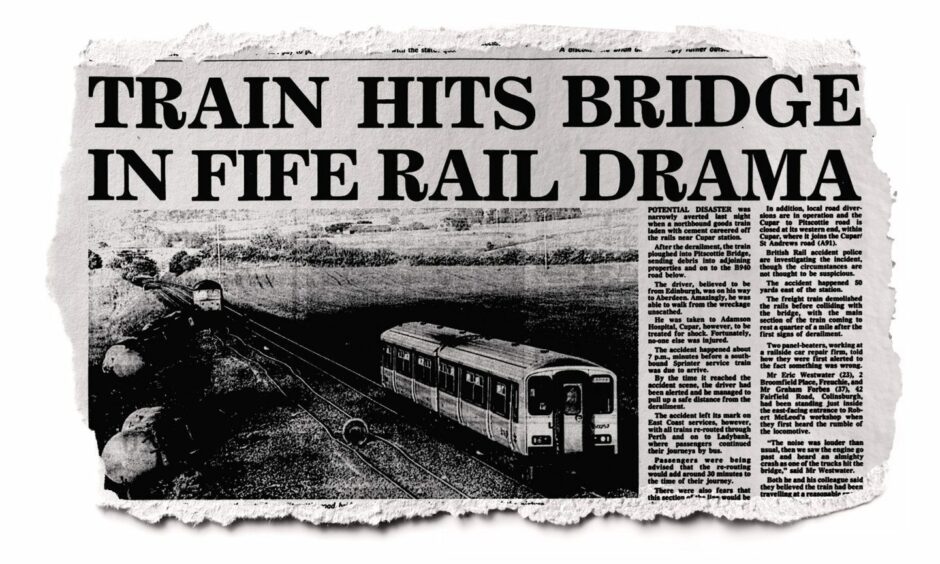 The rail crash hit the headlines back in June 1988. Image: DC Thomson.
The rail crash hit the headlines back in June 1988. Image: DC Thomson.
A “still-shaking” Patricia told The Courier afterwards: “We were going slow when we got on the bridge and all we could see was this big black cloud.
“I said to Christopher: ‘Look, it must be a puffing Billy’.
“But as the noise grew and the train got closer we realised it wasn’t that, at all.
“Edward slammed the car into reverse and managed to bring us off the bridge just as the train ploughed into it.
“It was just lucky there wasn’t any traffic behind us or we could easily have been caught in the flying debris.
“I don’t know what would have happened to us if that had been the case.
“As we were moving back we could see that the carriages were falling.
“I’m just thankful Edward acted the way he did to get us out of the way or we would have been showered with flying metal.”
[embedded content]
Edward ran down the tracks to see how the driver was and, after he found he was unhurt, returned to the car as help arrived from the station only 50 yards away.
Patricia said: “It was absolutely devastating.
“After we moved back all we could see was the cloud of smoke surrounding the bridge.
“We thought: ‘God the bridge must have collapsed’.
“A woman nearby even came running out of her house after the sheer force of the impact had shaken it so badly.
“She was obviously very concerned at what had happened, as I think everyone who quickly arrived was.”
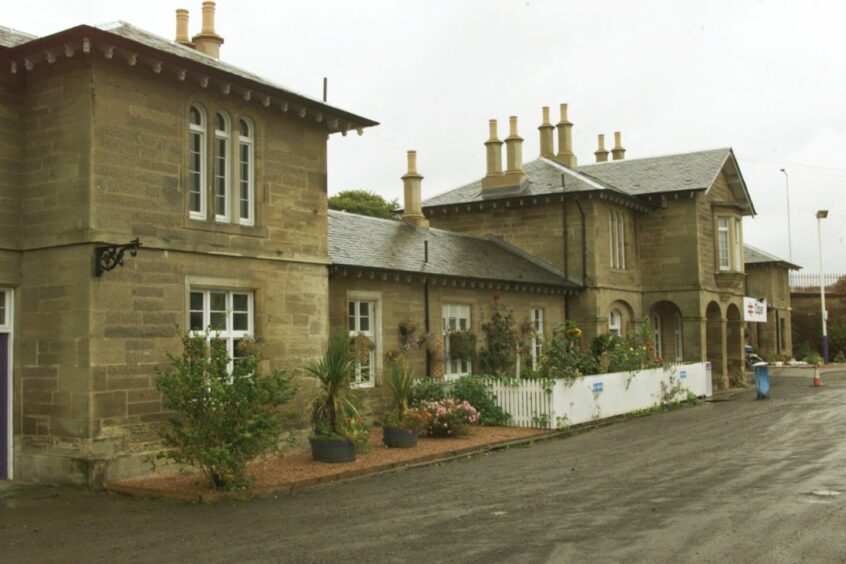 The accident happened only 50 yards from Cupar railway station, pictured. Image: DC Thomson.
The accident happened only 50 yards from Cupar railway station, pictured. Image: DC Thomson.
Patricia said it seemed that “literally hundreds of helpers came from nowhere” and realising they could be of little help they turned their attention to Christopher.
“He was very badly frightened by it like we all were,” she said.
They went down into the car park and had a cup of tea and let Christopher play in the park before later taking him back to back to show him that nobody had been hurt.
The McGee Vauxhall Corvette escaped only minor damage to the front lights.
Cursed track
The British Rail[2] Accident Investigation Branch arrived to investigate the incident before the full extent of damage became apparent as the task of repairs got under way.
Examiners examined the structural strength of the bridge — which would have to be rebuilt — and the dip in the road surface which was caused by the crash.
The southbound track which was covered in debris was examined for signs of stress.
Derailment workers rebuilt the shattered track to enable lifting gear to remove the damaged wagons, although not everything went to plan.
ScotRail’s efforts at removing the debris caused by the train crash were hampered on June 18 1988 when a rerailing crane was itself derailed.
Was this section of track cursed?
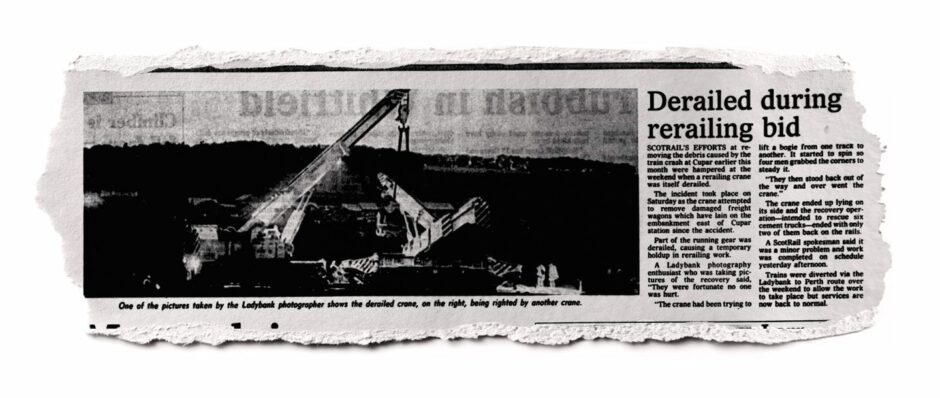 The derailment drama brought more unwanted headlines for British Rail. Image: DC Thomson.
The derailment drama brought more unwanted headlines for British Rail. Image: DC Thomson.
The incident happened as the crane attempted to remove the damaged freight wagons which had lain on the embankment east of Cupar[3] station since the accident.
A Ladybank photographer was taking pictures of the recovery at the time.
He said: “They were fortunate no one was hurt.
“The crane had been trying to lift a bogie from one track to another. It started to spin so four men grabbed the corners to steady it.
“They then stood back out of the way and over went the crane.”
The crane ended up lying on its side and the recovery operation — intended to recover six cement trucks — ended with only two of them back on the track.
The derailed crane was righted by another crane and work was completed on schedule.
It was a dramatic finale to a story that was already not short on drama.